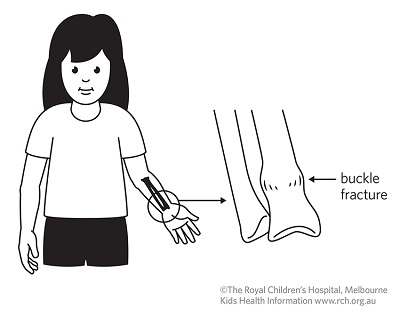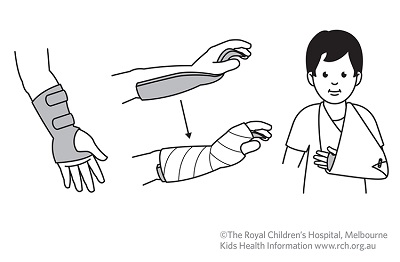A buckle injury of the wrist is a small area of compressed bone. The bone will have a very small fracture, which is so minor that it may be difficult to see on X-ray. The wrist may be tender, slightly swollen, and painful to move. There is no deformity in the wrist, which means the wrist will
not be out of its usual shape.

This fact sheet provides information on what to do once your child has been treated in hospital for a buckle injury. If you think your child has a fracture and you are looking for first aid advice, see our fact sheet
Fractures (broken bones).
Buckle injuries are treated by wearing a removable backslab (a partial cast held in place with bandages) or ready-made splint, which should be worn as much as possible but can be removed for bathing or showering. An arm sling is optional, and may help reduce any pain or
discomfort.

Care at home
Buckle injuries may be painful. Although immobilising the arm with the backslab or splint will help to reduce the pain, additional pain relief (e.g. paracetamol) is sometimes needed. Give the pain relief medication as required, following the directions on the packet or as directed by the
doctor.
Never cut or attempt to modify the cast, and make sure you avoid getting it wet.
Follow-up
Because buckle injuries are stable and heal quickly without problems, most children will not need a follow-up appointment with the GP or hospital. Further X-rays or physiotherapy are usually not required.
Three weeks after their injury, your child can just stop wearing their backslab or splint.
After the backslab or splint is removed
Wrist movement may be a little stiff and sore at first. Contact sports (or rough and tumble play) should be avoided for six weeks after the injury.
Take your child to your GP if:
- your child’s wrist remains very painful or swollen three weeks after the injury
- your child will not use their wrist, hand or fingers within two to three days of the back slab or splint being removed.
Key points to remember
- A buckle fracture in the wrist is a small area of compressed bone.
- Your child should wear a removable backslab (partial cast) or splint for three weeks. A sling may help reduce discomfort.
- Most children will not need a follow-up appointment or X-ray, because buckle fractures usually heal quickly without any problems.
- Avoid contact sports for six weeks after the injury.
For more information
Common questions our doctors are asked
Why doesn’t my child need a follow-up appointment?
In nearly all cases, buckle fractures heal quickly and with no complications. This is because the bone does not move out of alignment (correct position) and the fracture is small.
Will the fracture area be weaker forever?
There is no ongoing weakness of the bone following a buckle fracture. It may take some time for the muscles to regain their strength if the limb has been held still in a backslab. After your child no longer needs the backslab or splint, they will return to their normal strength and ability.
Developed by The Royal Children's Hospital and the Victorian Paediatric Orthopaedic Network. We acknowledge the input of RCH consumers and carers.
Reviewed November 2018.
This information is awaiting routine review. Please always seek the most recent advice from a registered and practising clinician.
Kids Health Info is supported by The Royal Children’s Hospital Foundation. To donate, visit
www.rchfoundation.org.au.